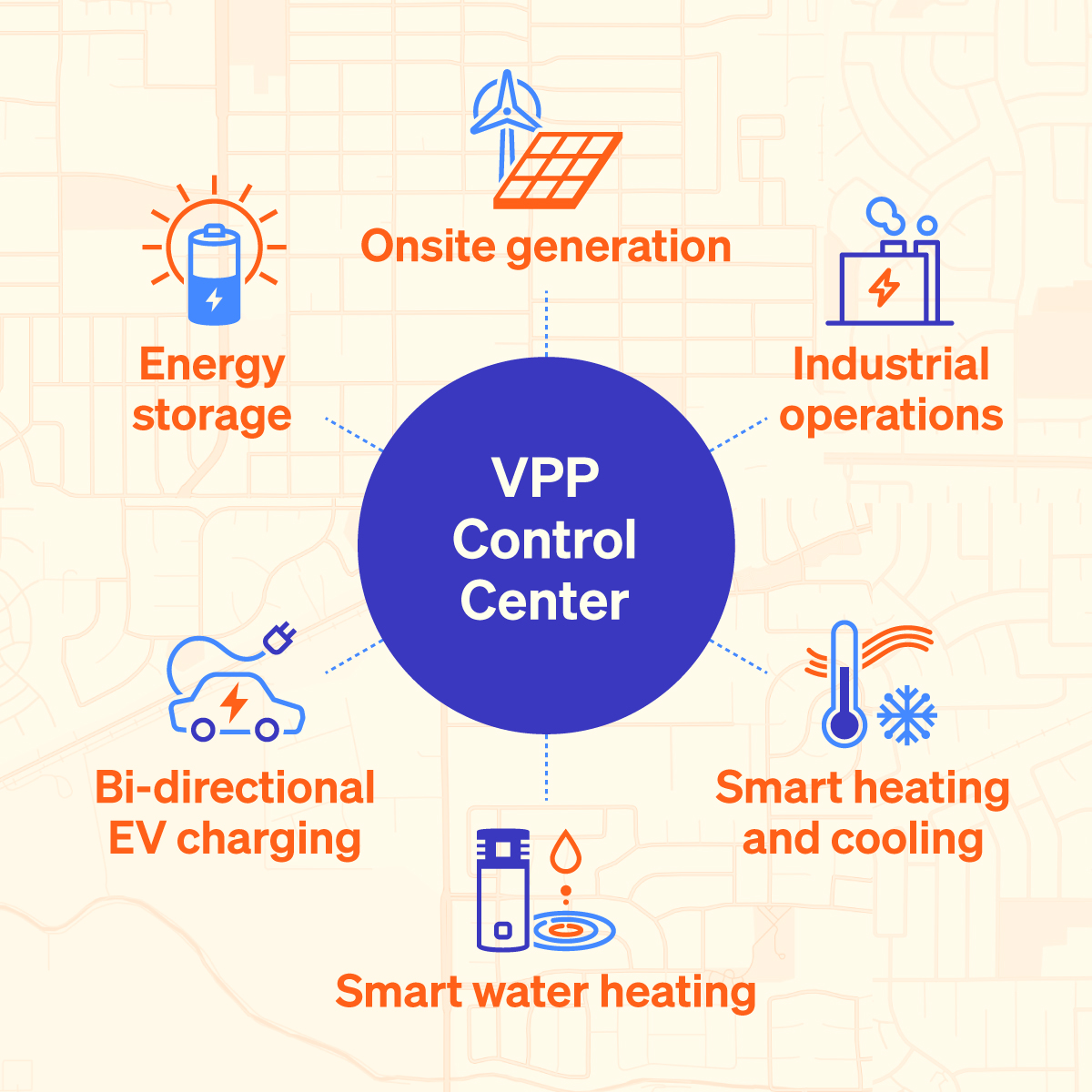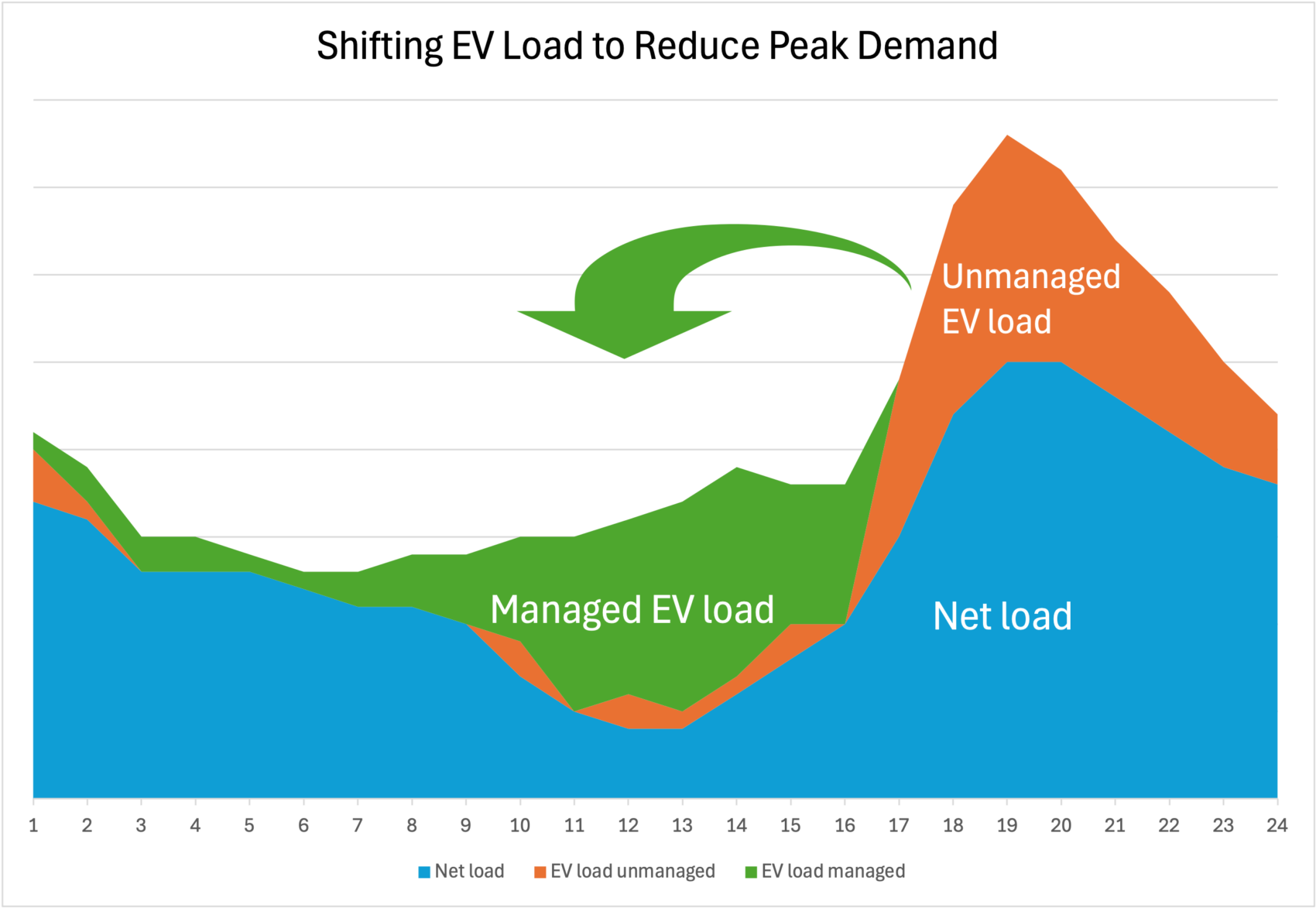Virtual Power Plants Create Real Benefits
September 17, 2024
Millions of distributed smart energy devices are being linked into “virtual power plants,” providing the same services that conventional power plants provide, but at lower cost and lower pollution. Ava has learned from pilot programs and is now expanding efforts to tap electric vehicle charging and home energy systems to provide grid services.

Ava is getting new clean power plants built, as it continues to sign contracts with solar, wind, and battery companies. But Ava is also working to build “virtual” power plants, aggregations of distributed generation and storage plus flexible load that can be controlled. Altogether, these VPPs have the potential to use digital technology and communications to accelerate the move to a zero-emission energy system, while boosting reliability and lowering costs.
What is a VPP?

There are millions of distributed and smart energy technologies in homes and businesses across the country, with more being added every day. Solar panels, batteries, electric vehicles, smart appliances, and thermostats all offer benefits to their owners, but they can also offer benefits to the grid.
Companies are now using software and wireless communications to control thousands of these devices together as “virtual power plants” or VPPs. Ava is working with companies to develop VPPs, with a focus on homes and electric cars.
When operated together, VPPs can function in aggregate very much like a conventional power plant, providing energy and capacity services. And they can give utilities greater awareness and control of the grid, increasing reliability and cutting costs.
About 120,000 California homes and businesses have installed batteries in conjunction with solar panels, adding up to nearly 1,400 megawatts of battery capacity, according to data from the California Energy Commission from last October. Alameda County is home to over 7,000 installations with 65 megawatts of capacity, with San Joaquin County adding another 1,600 systems and 16 megawatts.
New distributed solar installations are expected to slow down as solar net metering policies phase out, but are much more likely to be accompanied with batteries to make the most of the new “net billing” policy. So while rooftop solar may slow, battery deployment will likely increase.
A recent report from the US Department of Energy identified 30-60,000 megawatts of existing VPPs in the US, and called for tripling that number by 2030 to provide 10-20 percent of peak demand. Because VPPs would displace gas-fired peaking power plants and avoid grid upgrades, it could save $10 billion in annual grid costs, with much of the money flowing back to participating consumers.

What is the Ava VPP
Ava has been in the VPP business since 2020, working with the solar-and-storage company Sunrun on the Resilient Home program. In that program, 1,200 Ava residential customers get paid a flat fee to discharge their battery during the evening peak every weekday. This shaves Ava’s overall evening load, which reduces the amount needed to be bought from other sources.
Sunrun expanded the Resilient Home pilot in the summer of 2023, signing up 8,500 residential batteries in PG&E’s territory to discharge back to the grid for two hours every evening. The program provided the grid with an average of 27 megawatts of capacity each day, with battery owners paid a flat $750 fee for the three month pilot.
Now Ava is expanding the VPP concept with two new efforts.
As part of a new solar-and-storage program, Ava will offer an up-front incentive for batteries installed with solar, and an ongoing payment for batteries that discharge energy during evening hours and during peak events. The focus will be on residential customers, low-income households, and “resilience hubs,” facilities open to the public that provide community services.
Lunar Energy, a Distributed Energy Resource Management Systems (DERMS) company, will operate the program, providing Ava with centralized control to optimize for cutting carbon pollution, saving money for customers, and reducing procurement costs.
VPP for EV Charging
Ava is also bringing electric vehicle (EV) charging into the VPP.
While a home EV charger may draw only 6 to 10 kilowatts of power, adding millions of EVs to the grid could mean adding a lot of demand — if they charge at the same time. That is especially a risk if people get in the habit of plugging in when they come home after work. California’s peak demand period is already during the evening hours, especially in summer when solar power output fades and air conditioning demand remains strong. Millions of EVs charging from, say, 6:00 to 9:00 p.m. would make the problem even worse.
An easy solution is to manage when EVs charge up. A nine-to-five worker may drive home after work and not need a full car battery until they leave the next morning. Rather than charging as soon as the car is plugged in, smart controls can tell the car to wait until after peak hours, when prices are lower. It would then charge after midnight and be ready to go in the morning.
Managed EV charging can also shift charging to daytime hours when abundant solar power makes the grid very clean. Emissions tend to be highest during peak hours as natural gas generators fire up.
In the figure below, “unmanaged” EV charging adds to the evening peak demand, while “managed” charging shifts it to daytime hours, thus reducing peak demand and using more solar power.
Of course, this only works if the vehicles are able to be charged during daytime hours. This could mean focusing more on workplace charging rather than home, as well as making daytime rates lower and more attractive.

To manage the EV charging for Ava customers, Lunar Energy will be subcontracting with Optiwatt, a San Francisco-based company. Optiwatt runs managed EV charging programs, and offers software so users can schedule their charging and track exact consumption and costs.
Support is Growing
State policies are starting to support VPP deployment. In addition to counting VPPs toward resource adequacy (RA) requirements, new funding is starting to become available.
The Demand Side Grid Support (DSGS) Program is part of the state Strategic Reliability Reserve, a suite of programs created after tight power supplies in the West-wide heat wave of 2020. The new program has a $202 million budget to support distributed and demand-side approaches to reliability. Customers that cut demand during grid emergencies will earn an incentive of $2 for each kilowatt-hour (kWh) of load reduction relative to their typical energy usage.
If the VPP concept takes off, it could provide big benefits to California. A study by the consulting company Brattle Group found that VPPs could save California consumers $550 million per year and manage 15 percent of peak demand — five times the existing capability — by 2035.